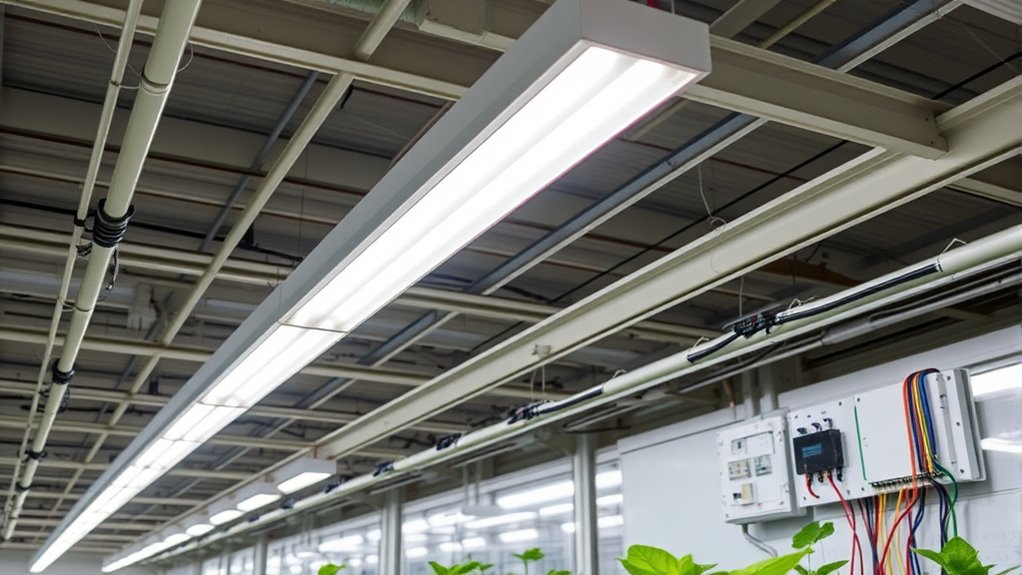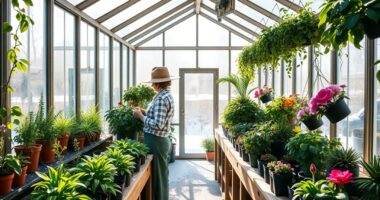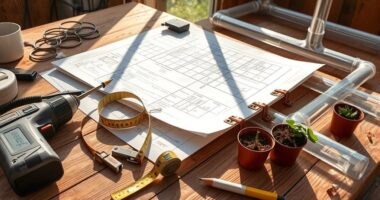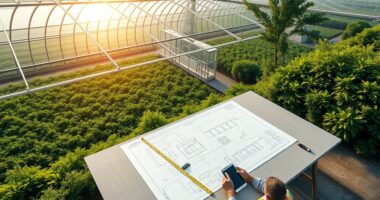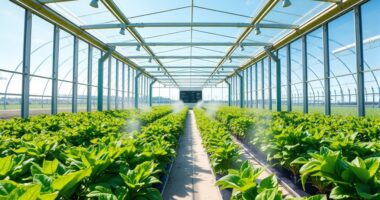To guarantee your greenhouse operates safely and efficiently, you need weatherproof wiring, properly rated circuit protection like breakers or fuses, and solid grounding following local electrical codes. Install dedicated circuits for lighting, fans, and watering systems to prevent overloads, and use durable, outdoor-rated cables with secure connections. Regular inspections and maintenance are key to safety and reliability. If you want to get into the specifics, there’s more to take into account for a well-designed electrical setup.
Key Takeaways
- Use weatherproof, outdoor-rated wiring and connectors suitable for greenhouse conditions.
- Install dedicated circuits for lighting, heating, and ventilation to prevent overloads.
- Ensure proper grounding of all electrical systems to protect against shocks and surges.
- Incorporate circuit protection devices like breakers or fuses rated for system demands.
- Plan electrical layout with secure, insulated wiring and accessible safety components for easy maintenance.
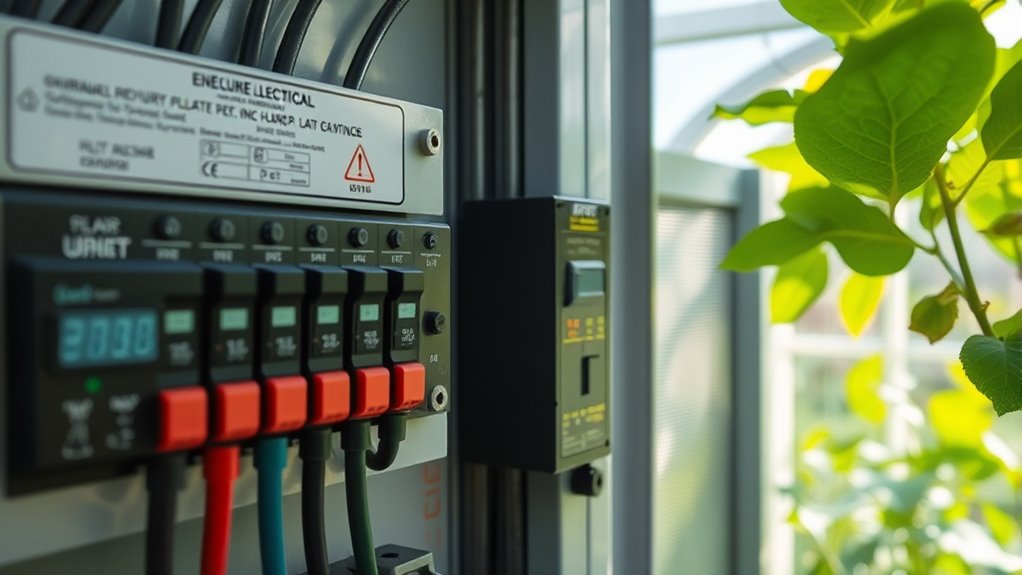
Setting up a greenhouse requires careful attention to its electrical system to guarantee safety and efficiency. To achieve this, you need to plan your electrical wiring meticulously, especially when it comes to integrating solar wiring. Solar wiring is essential if you’re considering using solar panels to power your greenhouse, as it ensures the energy captured from the sun is safely transmitted to your electrical system. Proper solar wiring involves selecting the right cables, connectors, and controllers to optimize energy flow and prevent issues like power loss or surges. When installing solar wiring, keep in mind that the wiring should be weatherproof and rated for outdoor use, with proper grounding to prevent electrical shocks.
Proper solar wiring ensures safe, efficient energy transmission for your greenhouse.
Equally important is circuit protection, which acts as the safeguard against electrical overloads and short circuits. Without adequate circuit protection, your greenhouse’s electrical system can become a safety hazard, risking damage to equipment or even fire. Using circuit breakers or fuses tailored to your system’s power demands helps shut off power instantly if a fault occurs. It’s a good idea to install these protective devices in accessible locations, making maintenance or emergency shutdowns straightforward. Circuit protection must be appropriately rated for your total load, ensuring it trips before wires or devices become dangerously hot.
Additionally, you should plan your electrical layout to include dedicated circuits for different greenhouse functions. For example, lighting, fans, irrigation systems, and heating units should each have their own circuits with proper circuit protection. This prevents overloads and allows you to isolate problems easily without shutting down the entire system. When wiring your greenhouse, always use high-quality, outdoor-rated cables and connectors to withstand moisture, temperature fluctuations, and UV exposure. Proper insulation and secure connections are indispensable to prevent shorts or corrosion over time.
Safety measures extend beyond just wiring; grounding your electrical system is fundamental. Grounding helps protect you from electrical shocks and redirects stray currents safely into the earth. Make sure your grounding system complies with local electrical codes, and use grounding rods or plates as recommended. Regular inspections of your wiring, circuit protection devices, and grounding system will help catch potential issues early, ensuring your greenhouse remains safe and operational year-round. Incorporating proper electrical planning from the outset can significantly reduce the risk of future electrical problems. Ultimately, a well-planned electrical system with robust solar wiring and effective circuit protection provides a reliable, safe environment for your plants and peace of mind for you.
Frequently Asked Questions
What Safety Precautions Are Necessary During Electrical Installation?
During electrical installation, you should prioritize grounding safety by guaranteeing all systems are properly grounded to prevent shocks. Use circuit protection devices like circuit breakers or fuses to guard against overloads and short circuits. Always turn off power before working on wiring, wear appropriate protective gear, and follow electrical codes. Double-check connections, and test the system thoroughly to ensure safety and reliability before powering up your greenhouse.
How Often Should Electrical Systems Be Inspected and Maintained?
You should inspect and maintain your electrical systems at least once a year to prevent electrical hazards. Regular maintenance schedules help identify potential issues early, ensuring safety and efficiency. Check for loose connections, damaged wiring, and corrosion regularly. Promptly address any problems to avoid risks like electrical shocks or fires. Staying proactive with inspections and maintenance keeps your greenhouse safe, compliant, and operating smoothly.
Can Existing Electrical Wiring Support Greenhouse Equipment Upgrades?
You need to assess your wiring capacity to determine if it can support greenhouse equipment upgrades. If your current wiring is outdated or undersized, you’ll likely require circuit upgrades to handle increased demands safely. It’s essential to have a qualified electrician evaluate your existing electrical system, identify any limitations, and perform necessary upgrades to guarantee your greenhouse operates efficiently and safely with new equipment.
Are There Specific Regulations for Electrical Work in Agricultural Buildings?
Yes, you need to follow specific regulations for electrical work in agricultural buildings. You must obtain electrical permits and adhere to wiring standards set by local codes and the National Electrical Code (NEC). These regulations guarantee safety and proper installation. Before starting any work, check with your local authority or a licensed electrician to confirm compliance, preventing future issues and ensuring your greenhouse’s electrical system is safe and reliable.
What Are the Energy Efficiency Considerations for Greenhouse Electrical Systems?
Think of your greenhouse as a thriving garden where energy efficiency blooms. Focus on renewable energy sources like solar panels to harness the sun’s power and reduce reliance on traditional grids. Use power optimization techniques such as LED lighting and smart controls to minimize waste. By doing so, you create a sustainable environment that nurtures your plants and conserves resources, ensuring your greenhouse grows greener with each passing day.
Conclusion
Ensuring your greenhouse has the right electrical setup is key to healthy plants and safe operation. For example, imagine installing a dedicated circuit for grow lights that prevents overloads and keeps everything running smoothly. By understanding these basic electrical needs and planning ahead, you can create a reliable, efficient environment for your plants to thrive. Don’t overlook these essentials—your green thumb will thank you for a safe, well-powered greenhouse!
